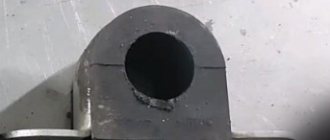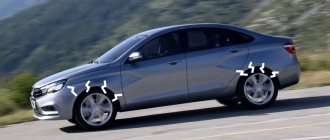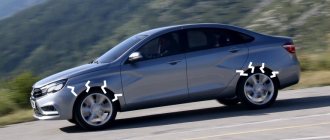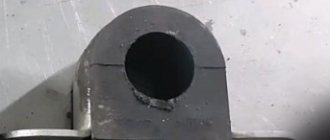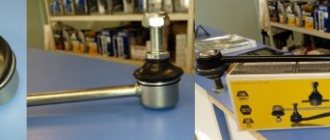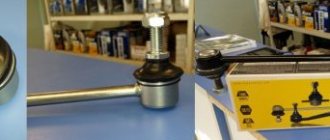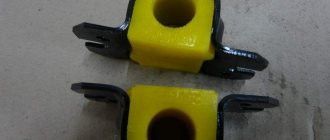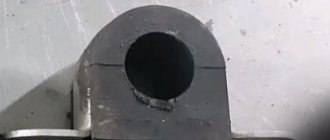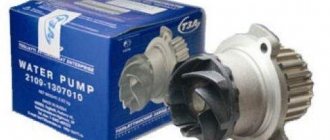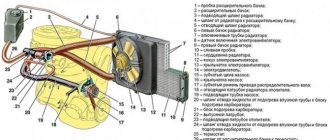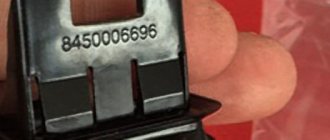Replacing an element such as stabilizer bushings on a Lada Vesta can be easily done with your own hands. It is for this reason that only inexperienced owners of cars of the model mentioned above turn to a car service center. As practice shows, often a specific and unpleasant squeak in the suspension area appears literally just a few days after purchasing a new vehicle. A simple inspection reveals that the problem lies in the stabilizer, which is responsible for its lateral stability (SST). In the aforementioned unit, the weak point turns out to be the bushing, or rather, the not very good material chosen “apparently – solely for the sake of economy” by the manufacturer for its manufacture.
Stabilizer - features
To better understand how to replace bushings with your own hands, you need to become familiar with the most common causes of their failure, be able to see signs of a malfunction and understand how the unit in question generally works.
The design of the front suspension mounted on the Lada Vesta was roughly copied from a similar Renault unit, but the domestic version turned out to be less advanced than the French prototype.
The torsion bar stabilizer is made from steel with high springiness. It itself is a rod that has a specific bend that helps reduce the lateral roll of the vehicle during turns at relatively high speeds. Without this element, the described maneuver may cause the vehicle to roll over.
In the case of Vesta, the stabilizer is installed exclusively on the front axle. The rod itself is fixed to the subframe with steel clamps and rubber bushings. From the edges the element is attached by levers to the suspension itself.
The operating principle of the stabilizer installed on the Lada Vesta is quite simple. The element distributes loads arising from any side evenly over the entire suspension. So, if the car begins to roll to one side, then the stabilizer rods change position. On the side where there is a critical slope, the node rises, and on the opposite side, on the contrary, it lowers.
The bushings that hold the front of the element allow it to rotate. This makes it possible to adjust the position of the body as the vehicle moves along the road. The stabilizer has another additional, but no less important function - improving the grip of the wheels on the road when entering a turn. Thus, the bushing takes on quite large loads, which contribute to the rapid failure of the part. Because of this, replacement (either with your own hands or in a car service) has to be done relatively often.
Creaks of the stabilizer bushing on Lada Vesta
As it turned out, the device's bushings, or rather the material from which they are made, are to blame. AvtoVAZ is aware of this problem, and there is hope that sooner or later everything will be resolved for the better.
While this time has not yet come, there are three solutions left:
- Lubricate the original, installed rubber bands;
- Replace with new ones, exactly the same (catalog number 8450006748) ;
- Exchange for similar ones from other models or brands of cars.
Rubber bands from KIA and Vesta brands.
The disadvantage of the first option is that the procedure will have to be carried out regularly as soon as an unpleasant sound appears from under the hood. This is guaranteed, since it is the material of the product that causes discomfort. An extraneous sound appears even on new cars after the first thousand kilometers . Buying another pair of substandard products is not a particularly encouraging prospect. Even dealerships offer to use analogues that are suitable in terms of characteristics for replacement.
What are the alternatives to standard bushings?
Practice shows that car enthusiasts have already coped with the task, having tried some options. According to them, analogues from :
- Chevrolet Niva, made of polyurethane (items 2123-2906046, 17012680) ;
Stabilizer bushings for VAZ-2123.
Hyundai-KIA stabilizer bushings.
In practice, there is no clear opinion regarding the first replacement. Some argue that the attempt counts. Others are sure that nothing has changed. There is even a special point of view, they say, it is polyurethane that causes grinding, contributing to additional wear of structural elements . There have never been any complaints about the Kia Rio.
Korean-made bushings definitely do not creak and are by far the best replacement, as it turns out, the only possible one.
True, it will not do without the additional headache of finding clamps for attaching to the body (article 54814-1G000) . There are no problems with them, you just need to order and wait a little for delivery. If our new imported parts are already in place, we can begin disassembling and installing new components.
Stabilizer bracket 54814-1G000.
When replacement is necessary
The failure of the stabilizer bushings on the Lada model under consideration is indicated by quite characteristic signs. So, in particular, on Vesta:
- there is a very loud creaking, and sometimes a knocking or even a grinding noise coming from the front suspension;
- the mentioned noises become especially loud if the car is moving on a bumpy road or after crossing a water obstacle;
- The car does not obey control well when the speed ranges from 60 to 90 kilometers per hour.
- when turning, the body rolls noticeably;
- turning the steering wheel requires more force.
Replacing stabilizer bushings on Lada Vesta
When removing elements, it is extremely important to do this when the load on the stabilizer is completely removed . This can be achieved using a lift, which will relieve the load on both front wheels. The second option is to jack up one wheel, install a reliable stop, and move on to the next one. Or use two jacks. The wheels are raised, let's start replacing. It will be the same for any of the selected options.
Required Tools
- open-end wrench 10×12;
- ratchet bit or L-shaped Torx T40 (star-shaped with six rays);
- socket wrench 13;
- knife to cut new pillows.
Dismantling sequence
We carefully clean the bottom of the car from dirt, paying special attention to the stabilizer bars and mounting bolts so that all the debris does not fall on your head. We take a key with a T40 bit and completely unscrew only one bolt securing the rod of the first bracket . We turn the second one out almost to the end so that you can release the bracket and turn it 180 0, using the remaining fasteners to fix it. We remove the creaking pillow, and do the same with the second bushing.
Unscrew the bolts securing the bracket rod.
In fact, it would not be possible to unscrew the bolts that are located on the steering wheel side, since the clamps will not allow this to be done. The fact that we have weakened it by at least 2/3 is quite enough. Provided that you want to change new bolts, the operation will be a little costly in time and effort . Dismantling the protection alone is not enough. You will need to slightly unscrew the bolts on the steering rack, lift it up, and remove the stabilizer pad brackets to the end. In some cases you have to completely remove the rail.
You can try one more method, but very carefully, so as not to violate the main principle of medicine - “do no harm.” With a little effort, move the anthers a little , as they are, together with the clamps. Our simple method of turning the staple together with the rubber band should work exactly.
Installation and assembly of unit bushings
Half the battle is done. We take new elements and use a knife to cut each one according to the marks made on the pillows . The material is very hard and will require some effort. Then everything is simple, we install the spare parts in place of the unsuitable ones, reassembling them in the reverse order. We tighten all the bolts tightly, and there is no need for additional lubrication.
We make a cut in the bottom of the new pillows and put them on the bar.
All is ready. Our Lada Vesta doesn’t care about potholes, speed bumps or other obstacles. Now there will be no more creaking or nervous tapping. The trip will bring you joy and a sense of inner peace.
How to prevent the stabilizer from squeaking
Each owner tries to improve his car, eliminating the flaws made by the largest domestic manufacturer. Vesta’s owners continue the tradition. In particular, they often think about how to improve the performance of the stabilizer.
The easiest way to rid the Lada of squeaking is to thoroughly lubricate the bushings. To do this, it is permissible to use silicone compounds or even WD-40. This recommendation, by the way, is also present in the official operating manual for the machine. The problem is that this measure is not enough for a long time - sooner or later the lubricant dries out, so its layer has to be renewed regularly. Moreover, the owners note that the described measure helps only at first.
A more effective way is to replace the bushings. However, it is not very wise to use original products, because they will not last as long as their predecessors. Thus, the best way out is to use elements from foreign cars, and then the stabilizer will start working, albeit not silently, but much quieter.
How to replace stabilizer bushings on Lada Vesta
Replacing an element such as stabilizer bushings on a Lada Vesta can be easily done with your own hands. It is for this reason that only inexperienced owners of cars of the model mentioned above turn to a car service center. As practice shows, often a specific and unpleasant squeak in the suspension area appears literally just a few days after purchasing a new vehicle. A simple inspection reveals that the problem lies in the stabilizer, which is responsible for its lateral stability (SST). In the aforementioned unit, the weak point turns out to be the bushing, or rather, the not very good material chosen “apparently – solely for the sake of economy” by the manufacturer for its manufacture.
Which bushings are suitable for Vesta
For those who are thinking about replacing the bushings with their own hands, we recommend throwing away the original rubber products and replacing them with polyurethane ones. It is easy to find them by article number - in the spare parts catalog they are designated as 17012680. This part has a similar internal diameter of 21.5 millimeters.
Bushings from:
- Chevrolet Niva 2123 (code – 17012680);
- Kia Rio (548132K100).
By the way, the fixing brackets from the last car (548141G000) will also work.
How to make a replacement
To change the bushings yourself, you will need to prepare:
- sets of Torx type keys (or similar bits for a screwdriver), as well as socket and ring ones;
- silicone grease.
Replacement is carried out in the following sequence:
- lift (hang) the front of the car with jacks;
- install supports;
- lock the front-wheel drive by turning on first gear at the gearbox;
- unscrew the bolts holding the wheels and remove them together with the disks;
- Use a 17 mm wrench to unscrew the nuts securing the lower and upper mounts (bones) of the stabilizer;
- on the left side of the torsion bar, find a pair of bolts holding the metal bracket in front and unscrew them.
Now you have direct access to the bushing, but to replace it you will need to remove the protection from the steering rack. This element is secured with 5 bolts. They are removed with a 10 mm wrench.
- unscrew the bushing;
- remove the rear bolts securing the mounting bracket;
- clean the torsion rod and degrease it with gasoline;
- when it dries, apply silicone grease;
- install a new bushing.
At the end, it remains to assemble in the reverse order from that described.
Reviews
| № | Positive |
| 1. | Petrovich , 35 years old (drive2.ru) Sverdlovsk: the car is a year old, I drive on the original bushings, no knocks, no rattles. I hope that they will last another 40 - 50 thousand km. |
| 2. | Vasily , 43 years old (prom.ua), Krasnodar: drove Vesta for two winters, original parts. There are no comments, the right side knocks a little, I blame the weak tightening of the rack. |
| 3. | Gennady , 38 years old (autotoday.com), Omsk: I won’t say that the quality of the original seals is super, but I’ve been driving for the third season and there’s no knocking. The manufacturer gives a guarantee of 60,000 km, let's see how long it lasts. |
| 4. | Vasily Gavrilovich , 48 years old (rozetka.ua), Rostov-on-Don: drove 45,000 km, a knock appeared on the right side. I went to the service station for diagnostics, the master said that the stabilizer bushings needed to be changed. |
| 5. | Dmitry Petrovich , 43 years old, Kursk (avtoflit.com): I bought the car second-hand, got it in good condition, well-kept. The speedometer shows 50,000 km, diagnostics showed good results. |
| 6. | Alexander Petrovich , 33 years old, Voronezh (autotoday.com): I’ve heard a lot of negativity about the quality of the seals, I can’t confirm it, since I’ve already driven 65,000 km on the factory ones. |
| Negative | |
| 7. | Vladimir , 38 years old (prom.ua), Uralsk: the speedometer already has 45,000 km, and the rubber bands on the stabilizers already need to be changed. Worn out very quickly, poor quality. It's better to buy from Kia, Toyota. |
| 8. | Mikhailovich , 44 years old, Moscow (avtoflit.com): I drove the originals for two winters, but it didn’t last longer. I heard that spare parts from Kia and Toyota are compatible. You need to get advice and install it at a service station. |
| 9. | Vladlen , 34 years old, Voronezh (drive2.ru): dissatisfied with the quality of production of the original bushings, they have already flown 45,000 km. I will buy foreign analogues, since the quality there is much better. |
| 10. | Mikhail Petrovich , 35 years old, Pskov (autotoday.com): on my first car Lada Granta, the spare parts took longer to take care of, why this is the case with the Lada Vesta, I don’t know. I think the reason is the quality of domestic components. |
Required Tools
To work you need to prepare the following tools:
- head 10;
- spanner 16;
- hex open-end wrench 16;
- spanner 13;
- two jacks, if there is no inspection hole or overpass;
- Silicone Grease;
- rags.
Replacing the Lada Vesta stabilizer bushings with your own hands is quite advisable, since work in a car service center will cost at least 450 rubles as of 05/31/2019. In addition, you will save personal time and independently audit adjacent components and systems. Faulty bushings are indicated by:
- extraneous noise in the front suspension;
- deterioration in vehicle controllability at speeds of 60 km/h or more;
- the appearance of squeaking when driving through puddles or on roads with uneven surfaces.
Regardless of the reasons (negative impact, aggressive driving, poor quality bushings), if signs of malfunction appear, repairs must be made immediately.
